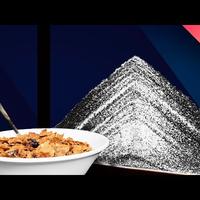The Weird Science of the Raisin Bran Effect
Hey smart people, Joe here. You know what I freakin' love? Cereal. You know what I
hate? The cereal at the bottom of the box.
Ever notice how by the time you get to the bottom, you're left with this? It's just
little crumbs and boring stuff. The dregs, if you will. The tastiest big bites
are gone. But… that doesn't really make sense. If cereal is mixed in the
box, shouldn't it stay that way? Or if anything, why doesn't the bigger, heavier stuff sink to the bottom?
Watch what happens when I shake up this bag.
When I pour the cereal out, there's more delicious bits in the first bowls, from the top of the bag.
Why does this happen?! The answer… is science.
Well, technically that's the answer to everything. But especially this!
Ok, back to why does this happen… Well it's curious that the heavier bits rise to the top instead of falling to the bottom.
Well the same thing happens with granola and …nuts.
Shaking a can of mixed nuts doesn't actually
mix them up… it UN-mixes them, and big nuts like Brazil nuts always rise to the top.
That's why this strange phenomenon is commonly called the “Brazil Nut Effect,” though
I don't really like Brazil nuts, and I LOVE Raisin Bran, so I'm renaming it the Raisin Bran Effect!
And it's powered by physics.
When we shake something up, we expect it to get more random.
But for many mixtures, that isn't what happens. Shaking them actually makes them less random.
Scientists started digging into this strange phenomenon in the late ‘80s, and how it works is still kind of
driving them nuts.
The key ingredient is motion. To make particles
move, we have to accelerate them. And for these particles, that means accelerating them
enough that they overcome gravity.
They bounce, or jump, and that allows them to rearrange.
There are a couple different mechanisms going on here.
One is called granular convection. Granular means it's made up
of small grains or particles, and moving by convection, a sort of rolling flow.
In a container, as things get vibrated and
jostle around, the friction between the grains and the side walls draws particles near the
edges down. Particles near the center are pushed up, and we get convection swirls.
Even if there's a big dense object in the
mix, it gets shoogled up the middle by the convection currents - and it stays there.
That's right, I said “shoogled”.
It's a new Scottish word I learned that means “to shake”… and it is awesome.
But there's another way this sorting can
happen besides convection: it's called percolation.
Basically small particles fall into the cracks left by their bouncing neighbors. And as they
fill in those spaces, the bigger particles get pushed towards the top.
Think of it like a ball bouncing on a platform that levels up every time the ball jumps.
We can see this in a really cool way with
some sand, some salt and this thing I built.
Watch what happens when I pour it through this little hole.
See that? They separate!
If we look closely, we can see that when the
different grains impact, they're still pretty mixed, but as they settle, the layers start building.
Larger grains quickly roll down the hill, but the smaller grains get
stuck in cracks along the way. As the small stuff fills in empty spaces, large particles
roll along on top of it. The process repeats, and that
gives us those nicely stratified layers.
Ok - so this is cool and all, but do percolating
particles and granular convection actually matter in the real world?
It does if you're caught in an avalanche.
Avalanche airbags inflate around a person tumbling and being buried by snow.
They don't float you up, the way a lifejacket floats
you in water. They basically turn you into a human brazil nut, a big particle rising
in a mix of smaller snow!
Physics can save lives. Who knew!? Actually…
car airbags, seatbelts, ejection seats, bulletproof vests, MRIs. I guess that's not really news.
Anyways…
Even rocks in river beds separate this way,
the larger ones on top. And it shows up in space! It's one explanation for large boulders
on the surface of asteroids that have no other business being there.
Best part? You can try this at home! Shake a bowl of popcorn to get the biggest, fluffiest
kernels to the top. It even works with a bowl of chips.
In fact, I want to know where you find this effect. Send me a video the next time YOU
see the Brazil Nut Effect… I mean the Raisin Bran Effect, in action.
Stay curious.
And it's good for you, too!

